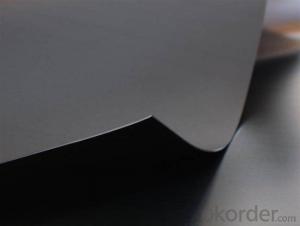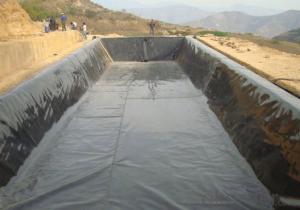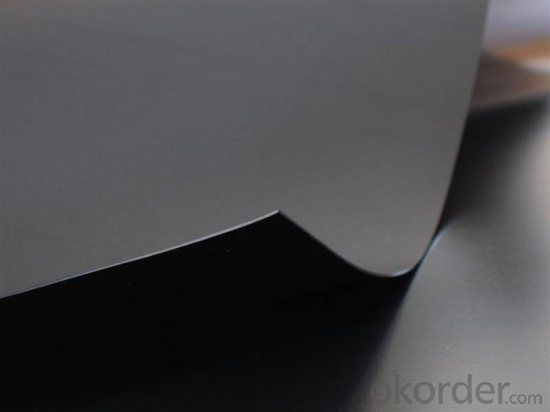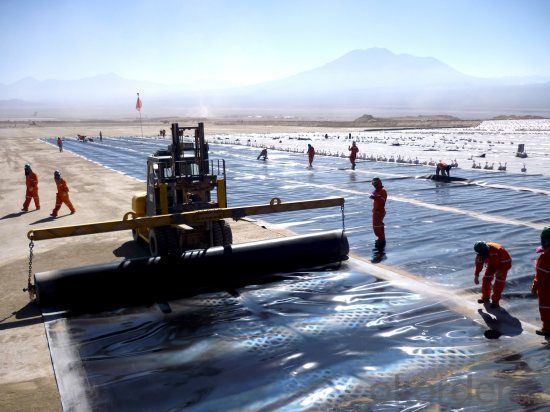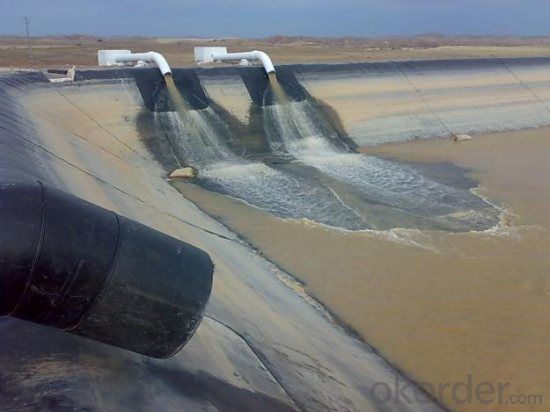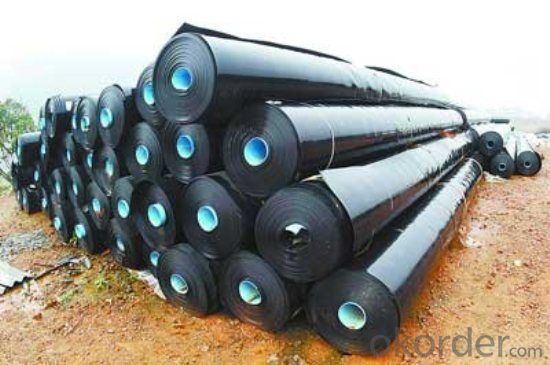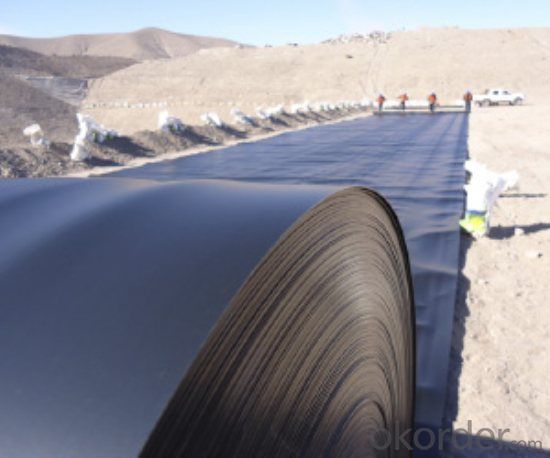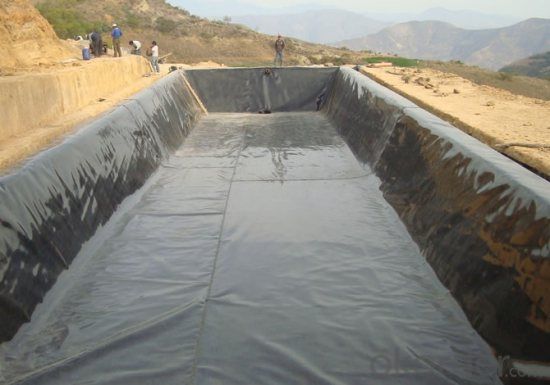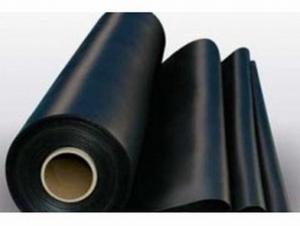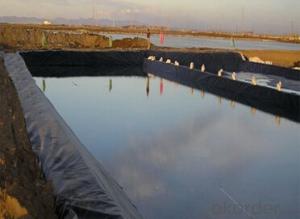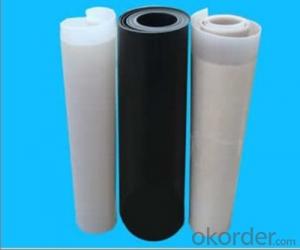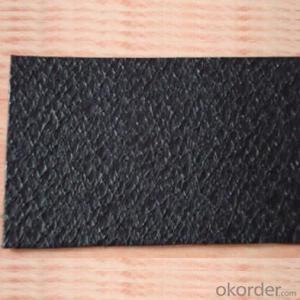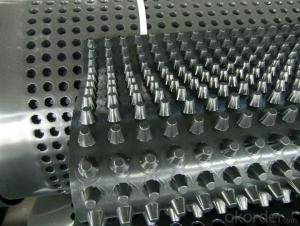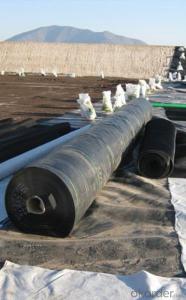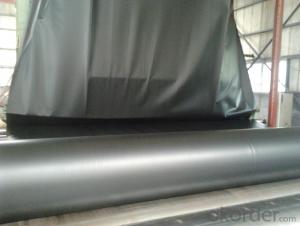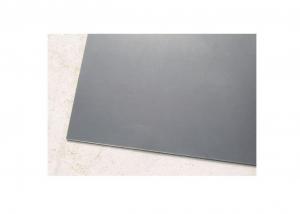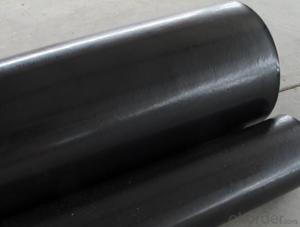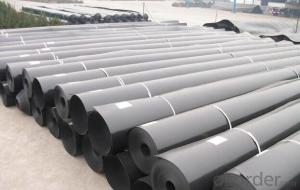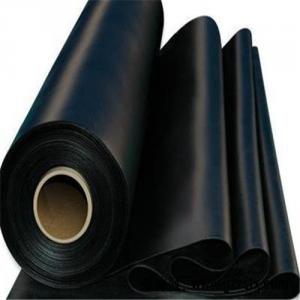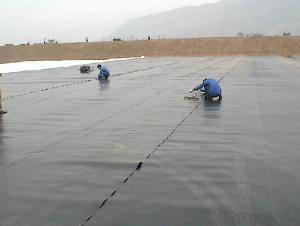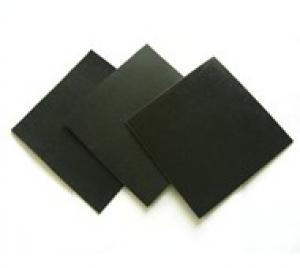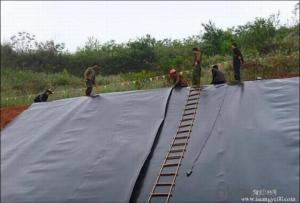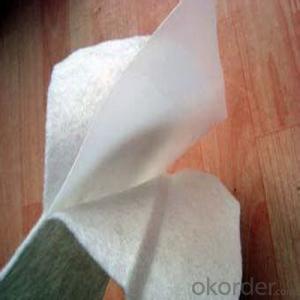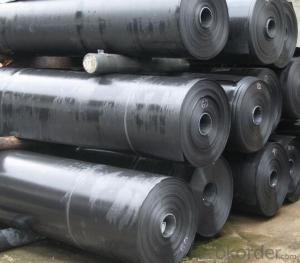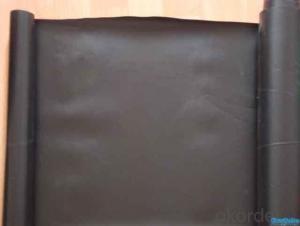Geomembrane Anchor HDPE for Architectural Engineering
- Loading Port:
- Qingdao
- Payment Terms:
- TT or LC
- Min Order Qty:
- 10000 m²
- Supply Capability:
- 100000 m²/month
OKorder Service Pledge
OKorder Financial Service
You Might Also Like
Geomembrane HDPE for Architectural Engineering
Description Of Geomembrane HDPE for Architectural Engineering
Geomembrane, also known as water-proof plate, is made from polymer materials like polyethylene, through blow molding.
Main Features of Geomembrane HDPE for Architectural Engineering
By its raw materials - molecular structure, Polyethylene (PE) geomembrane is divided into low-density polyethylene (LDPE) geomembrane, linear low density polyethylene (LLDPE) geomembrane, high-density polyethylene (HDPE) geomembrane;Aside from colorless and transparent raw material, you can made it into the black, green, blue, yellow, etc by adding different color masterbatch., also made into geomembrane with the black front and the blue back or other 2 different colors as required by customers.
Applications of Geomembrane HDPE for Architectural Engineering
1. HDPE geomembrane is applicable to environmental protection and sanitation: such as landfill, sewage treatment plant, power plant adjustive pool, industrial, hospital solid waste;
2. HDPE geomembrane is applicable to hydraulic engineering: such as seepage control, plugging, reinforcement for rivers, lakes and reservoirs and dams, drainage seepage control, vertical core wall, slope protection, etc.
3. HDPE geomembrane's applications in municipal engineering: subway, underground works of the building, planting roof, roof garden, sewage pipe seepage control;
4. Polyethylene impermeable membrane is applicable to the garden: artificial lake, river, reservoir, golf course pond bottom, slope, green lawn waterproofing and damp-proofing;
5. High density polyethylene geomembrane is applicable to petrochemical industry: chemical plant, oil refinery, storage tank seepage control, chemical reaction cell, lining and secondary lining for sedimentation tank, etc.
6. Polyethylene geomembrane is applicable to mining: washing pool, soaking pool, the ash-field, dissolving pool, settling pool, yard, tailings substrates seepage control;
7. Low density polyethylene geomembrane for transport facilities: foundation reinforcement for the road, culvert seepage control;
8. HDPE geomembrane is applicable to agriculture: seepage control for reservoir, drinking water pool, water storage pond, irrigation system;
9. HDPE geomembrane is applicable to aquaculture industry: the lining of intensive factory farming ponds, fish ponds, shrimp ponds, the sea cucumber ring slope protection, etc;
10. HDPE geomembrane is applicable to Salt industry: saltworks crystalline pool, brine pool thatch cover, salt membrane, the salt pool plastic sheet membrane.
IMages of Geomembrane HDPE for Architectural Engineering
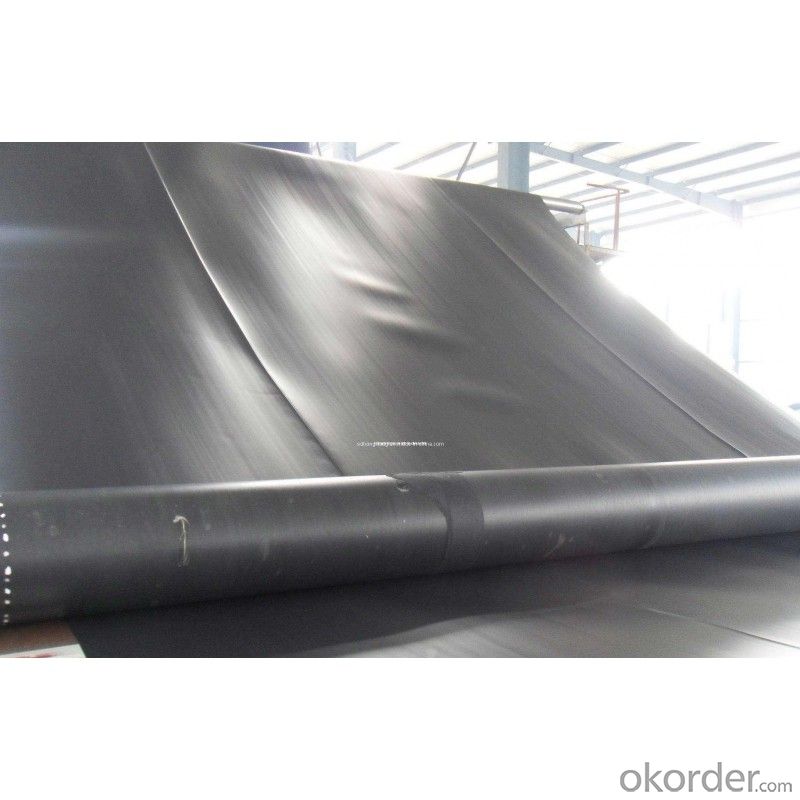
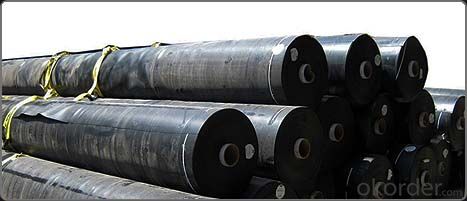
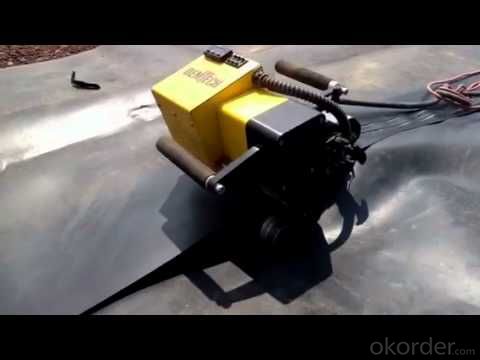
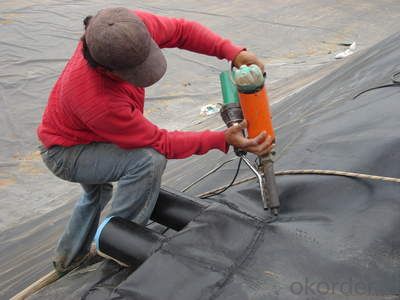
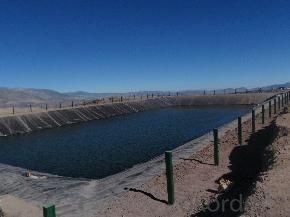
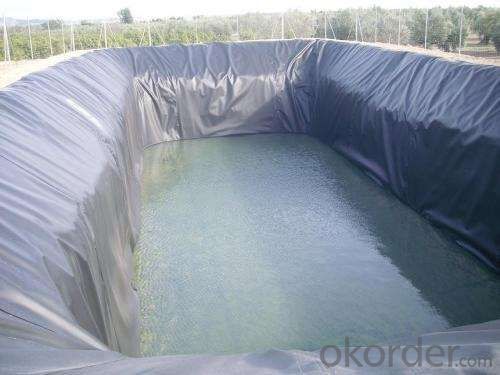
FAQ:
1. What are we supplying?
We are specialized in producing .geotextile , geocell, geogrid, geomembrane
2. How Many years experience do we have?
We have been exported to more than 15 countries in the past 10 years.
3. How long do we usually reply your request?
We always reply our customer within 12 hours.
- Q: How to use geosynthetics impervious device?
- The geosynthetics impervious device is designed according to national standard of permeability?coefficient. It is applied to test seepage resistance of all kinds of geosynthetics. It is convenient and practical with stable performance. Installation and use methods are as follows. 1. Set pressure. Press the set button "back" and the button ">" after powering on the device. Press the button “+”and“--”, then set pressure. After that press the button "back" to save it. After setting the lower limit value, press the set button to exit. 2. Clear the time setting. Redo the test and continue pressing the "--" button. The time value will be reset to 0 after 10 seconds. Don't press the button during the working time. 3. Check the time. Press the "--" button. The time value accurate to seconds will be shown on the screen. After 30 seconds, pressure value will be shown on the screen again. 4. Adjust to zero. If the pressure setting can't return to zero when the device is powered on without being applied pressure, you can press the reset button once. If the device is under pressure, release the pressure before pressing the button. 5. Open water injection cover plate. Add pure water until the water tank is full. Apply pressure and open pressure regulating valve to let water flow to chassis of high pressure cabin until the water begins to overflow. 6. Put the sample on the net plane of water collectormanifold smoothly. Let the excess water drain away to ensure that there are no bubbles in sample clamping device. Close the perforated plate and fix the sample evenly.
- Q: Can geomembranes be used in decorative landscape designs?
- Yes, geomembranes can be used in decorative landscape designs. They can be used to create ponds, water features, retaining walls, and other decorative elements. Geomembranes provide a waterproof barrier that helps to prevent leaks and maintain the integrity of the design. Additionally, they can be easily hidden or covered with natural materials to blend seamlessly into the landscape.
- Q: What should pay attention to in the construction of geomembrane?
- The best method is using buried laying. During construction, first of all, level out the base surface with smaller sand or clay, and then pave geomembrane. Don't stretch geomembrane too tightly, both ends embedded in the soil section is corrugated and finally pave a layer of about 10cm transition layer with fine sand or clay on paved geomembrane. Block 20-30cm stone (or concrete precast block) as scour prevention layer. It is better to avoid the stones to hit on geomembrane, and it is better to carry on the construction of the protective layer while pavement of geomembrane.
- Q: How do geomembranes help in preventing soil erosion in coastal areas?
- Geomembranes help in preventing soil erosion in coastal areas by acting as a barrier between the soil and the surrounding water. They are impermeable and resistant to chemical and biological degradation, which prevents water from penetrating into the soil and washing it away. Additionally, geomembranes provide stability to the soil by reducing wave and tidal energy, thereby minimizing the erosive forces that cause soil erosion.
- Q: What are the features of environmentally friendly geomembrane?
- Because it has strong tensile strength, high impact strength, impermeability, acid and alkali resistance, heat resistance, weatherability and wear-resistant properties, seepage-proof geomembrane is widely used in construction industry in coastal areas. It is also widely used in rivers and dams, reservoirs, diversion tunnels, highways, railways, airports, underground, underwater and other projects.
- Q: Architectural glass film benefits include:
- 1, insulation to reduce cooling costs: summer LLumar film can effectively block 79% of the sun's heat, greatly reducing the solar energy into the room, thereby reducing the cost of cooling the building. 2, thermal insulation to reduce heating costs in winter: the low-emissivity (LOW-E) film attached to the inner surface of the ordinary single glazing can reduce heat loss by 30%, reduce indoor heat loss, reduce winter heating costs.
- Q: What are the advantages of using geomembranes in biogas systems?
- There are several advantages of using geomembranes in biogas systems. Firstly, geomembranes act as a barrier, preventing the leakage of biogas into the surrounding environment, thus reducing the risk of greenhouse gas emissions. Secondly, they help in the retention and concentration of biogas, improving the overall efficiency of the system. Additionally, geomembranes are durable and resistant to chemical degradation, ensuring a longer lifespan and lower maintenance costs. Lastly, they provide flexibility in system design, allowing for easy installation and customization according to specific project requirements.
- Q: What are the considerations for geomembrane selection in wastewater treatment plants?
- Some considerations for geomembrane selection in wastewater treatment plants include the material's chemical resistance, durability, flexibility, and compatibility with other components of the treatment system. It is important to choose a geomembrane that can withstand exposure to various chemicals and contaminants commonly found in wastewater. Additionally, the chosen geomembrane should have a long lifespan and be able to withstand physical stresses such as UV exposure, temperature fluctuations, and mechanical damage. Flexibility is also important to ensure the geomembrane can conform to the shape of the treatment system. Lastly, compatibility with other components such as pipes, valves, and fittings should be considered to ensure proper installation and functionality of the system.
- Q: Are geomembranes resistant to frost and freeze-thaw cycles?
- Yes, geomembranes are generally resistant to frost and freeze-thaw cycles. They are designed to withstand environmental conditions, including extreme temperatures, without losing their structural integrity or performance.
- Q: What are the advantages of using geomembranes in hydroelectric power generation projects?
- There are several advantages of using geomembranes in hydroelectric power generation projects. Firstly, geomembranes act as an impermeable barrier, preventing water leakage and ensuring efficient water containment. This helps in maintaining a consistent water level within the reservoir, ensuring optimal power generation. Secondly, geomembranes are highly durable and resistant to UV rays, chemicals, and other environmental factors. This makes them suitable for long-term use in harsh conditions, reducing the need for frequent maintenance and replacement. Additionally, geomembranes can be customized to fit the specific requirements of each hydroelectric project, providing flexibility in design and construction. They can be installed quickly and easily, reducing construction time and costs. Furthermore, geomembranes help minimize environmental impacts by containing any potential leaks or spills, preventing contamination of surrounding ecosystems and water sources. This promotes sustainable and responsible hydroelectric power generation. Overall, the use of geomembranes in hydroelectric power generation projects offers advantages such as water containment, durability, customization, and environmental protection, making them a valuable component in the construction and operation of such projects.
Send your message to us
Geomembrane Anchor HDPE for Architectural Engineering
- Loading Port:
- Qingdao
- Payment Terms:
- TT or LC
- Min Order Qty:
- 10000 m²
- Supply Capability:
- 100000 m²/month
OKorder Service Pledge
OKorder Financial Service
Similar products
Hot products
Hot Searches
Related keywords
